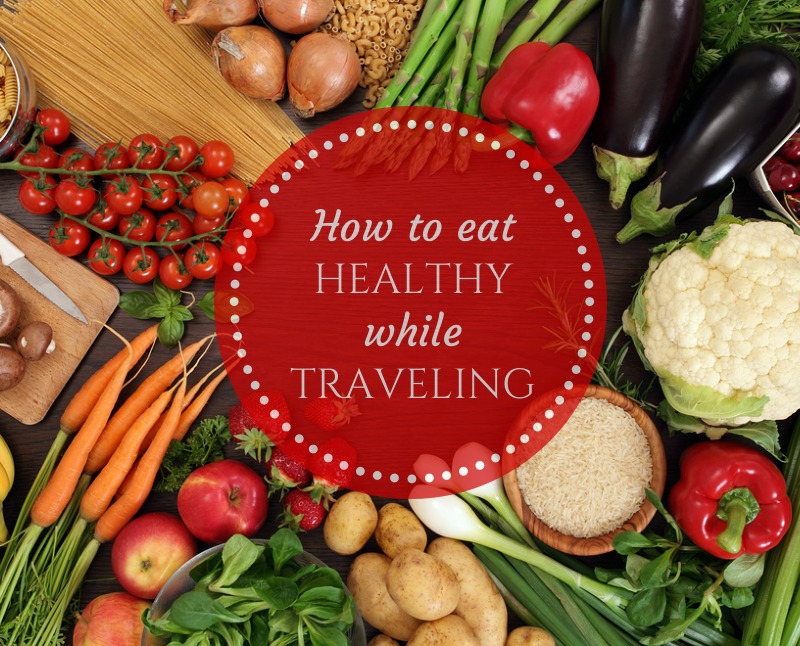While far more of us are traveling today, trying to eat healthy while doing so can often times become one of life’s biggest challenges. Whatever the endeavor, whether it’s traveling for work, visiting friends or family, or just taking a vacation the trial to stay on task with eating healthfully can be more than mildly perplexing.
And although your eating won’t be perfect, there are a number of strategies you can put into play that will certainly help.
Because travel looks different depending on the type and destination, you can adapt the strategies below to your individual situation – whether that includes flying, car trips, bus rides or a combination.
Planning Ahead
Before you leave, I encourage you to already have the decision made about what foods you need to stay away from and what foods you’re willing to let slide in certain situations. When you do that, you’ll spare yourself the stressful mental thinking when opportunities arise. This will lessen your chances of experiencing any painful discomfort from eating a so called “forbidden food” the next day. You will also be able to plan ahead better about what kind of foods to bring with you and how much you’ll need.
For instance, maybe you’re sensitive to gluten so you know that’s a forbidden. On the other hand you know that items fried in vegetable oils aren’t on your list of healthy foods –like sweet potato fries– but you decide to let them slide on occasion. Just try to limit your “slides” to once every few days so it doesn’t add up to disaster by the end of your travels.
Hotel Stays
Always try picking a hotel that offer rooms with a mini-fridge. Not only will you be able to harness healthy foods in your room for easy access, you will also save money by bringing your own breakfast, lunch and snack foods which can add up quickly on vacations.
Also, if you’re looking at a few different hotels, search out each of them on the net in accordance to how close they are to surrounding grocery stores or markets. The closer they are, the easier it will be to make as many stops as you need for healthy options throughout your trip.
Although typically not the best quality food, it’s good to check out hotel breakfast options ahead of time, as well, to see what foods might be available to you. Stocking up on hard-boiled eggs or fruit from the breakfast buffet can serve as breakfast or snacks during your stay.
And lastly, I highly recommend using review sites to search the city you’re visiting for healthier food choices in restaurants, cafés and other eating establishments using key words like healthy, natural, organic or grass fed. This will quickly give you an idea of where to eat along with reviews on how their food and service is.
Take-along Foods
You can easily take a variety of perishable and nonperishable items with you depending on the length of your trip, and how much room you have to pack food.
Perishable
For perishable foods, depending on your type of travel, you can use a cooler or a shoulder strap cooler bag along with gel ice packs to keep foods cold during your travel time. If flying and you’re unsure if your ice source is security-friendly, take a large Ziploc bag and get ice from a drink shop once you’re inside the terminal.
Perishable friendly travel foods:
- Raw vegetables like carrots, broccoli and cauliflower tossed in extra virgin olive oil.
- Hard boiled eggs
- Pre-cooked sweet potatoes
- Meats like shrimp or chicken and beef pre-cut into strips
- Single serving packs of guacamole
- Slices of real cheese
For flights that may include long layovers or in-flight meal services, it’s best to prepare your own to-go meal before leaving the house. Dry foods are perfectly acceptable to take in carry-ons, so take as much as you need.
Non-perishable
Packaged foods or foods that don’t need immediate refrigeration are a great resource for emergency meals and snacks, especially when spending long hours away from the hotel due to work or other obligations. In those instances you can pack large stashes of these foods in your suitcase, and take what you’d like in your carry-on for immediate use.
Non-perishable friendly travel foods:
- Jerkies or Beef sticks
- Protein bars – but watch the sugar content
- Raw nuts and seeds
- Individual packets of peanut butter, almond butter and other nut butters
- Canned (or packaged) salmon, tuna, sardines or other fish
- Fruits like apples, bananas, avocados and oranges
Accessories
A few accessories that may come in handy are reusable eating utensils, plates and napkins will help as you prepare and eat your food throughout your stay.
Don’t be shy about taking any other small conveniences that make you feel comfy. This includes supplements you might be taking like protein powder, fish oil or probiotics, or bags of your favorite tea you like to drink in the morning. Especially when traveling frequently for work, keeping a somewhat normal routine is pretty critical to staying in control.
Dining Out
Whether traveling for work or vacation, experiencing new, local restaurants can be a relaxing highlight of any trip. Luckily, you can enjoy the food at a majority of the eating establishments you’ll visit by following these 6 tactical tips.
1. If picking your own restaurants, search the net using keywords like healthy, organic, grass-fed, vegetarian, gluten-free or whatever your preferences are along with name of city you will be visiting.
2. When you arrive at a restaurant, tell the waiter of any food intolerances you may have, and that you would appreciate their help in making substitutions. Most of the time, they’ll make immediate recommendations and let the chef know of your sensitivity.
3. When ordering salads, simply ask for the dressing on the side or sub the dressing for a side of olive oil. Also ask them to hold the croutons and go light on the cheese.
4. You can order any burger dish by simply asking them to hold the bun, and leave any sauces on the side. Also avoid items that are fried in vegetable oils, sub out the fries for other sides they offer like grilled vegetables or rice.
5. You can order any entrée dish that includes meats like steak, fish, or chicken by simply asking them to double up the veggies as your side instead of any starch or processed dairy items.
6. If you’re trying to avoid vegetable oils, ask if there is an option to have your meat or vegetables cooked in butter instead of the typical canola oil that most restaurants use.


